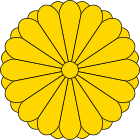- Ministry of Taxation
-
Pre-modern Japan 
This article is part of the series:
Daijō-kan
Council of State- Chancellor or Chief Minister (Daijō-daijin)
- Minister of the Left (Sadaijin)
- Minister of the Right (Udaijin)
- Minister of the Center (Naidaijin)
- Major Counselor (Dainagon)
- Middle Counselor (Chūnagon)
- Minor Counselor (Shōnagon)
- Ministry of the Center (Nakatsukasa-shō)
- Ministry of Civil Services (Shikibu-shō)
- Ministry of Ceremonies (Jibu-shō)
- Ministry of Taxation (Minbu-shō)
- Ministry of the Military (Hyōbu-shō)
- Ministry of Justice (Gyōbu-shō)
- Ministry of the Treasury (Ōkura-shō)
- Ministry of the Imperial Household (Kunai-shō)
_____________________
Meiji government
_____________________
Postwar Shōwa period
- Imperial Household Agency (Kunaichō)
The Ministry of Taxation (民部省 Minbu-shō) was a division of the eighth century Japanese government of the Imperial Court in Kyoto,[1] instituted in the Asuka period and formalized during the Heian period. The Ministry was replaced in the Meiji period.
Contents
Overview
The ministry was established by the Taihō Code and Ritsuryō laws.[2] The need for funds for the expenses of the Imperial Household evolved over time.
The ambit of the Ministry's activities encompasses, for example:
- supervision of the census of the population of the various Provinces[3]
- regulation of the contribution of forced labour as tax[3]
- determining exemption from forced labour as tax[3]
- rewarding of subjects distinguished for filial piety, or for their integrity in dealing with other people, or of subjects in distress, or of officials of certain classes[3]
- maintenance of bridges, roads, harbours, lakes, farms, mountains, rivers, etc.[3]
- administration of the estimation and collection of taxes in products[3]
- oversight of the disbursement of the national funds and estimates of national expenditures[3]
- maintenance of granaries[3]
- regulation of the land tax[3]
History
When the Ministry was initially established in 646, its main task was controlling agriculture.[4]
The way in which finances were handled by the Imperial Household changed over time. This ministry came to be concerned with the general populace, with police activities, and with land survey records. Registries for all towns and villages are maintained, including census records as well as birth and death records.[5]
Hierarchy
The top ritsuryō official within this subdivision of the daijō-kan was the chief administrator of the Ministry of Taxation (民部卿 Minbu-kyō).[5] Among those who held this office was Fujiwara no Tameie.[6]
Other officials were:
- First assistant to the Minister (民部大輔 Minbu-taifu).[5]
- Second assistant to the Minister (民部少輔 Minbu-shō).[5]
- Senior undersecretaries (民部丞 Minbu-no-jō), four positions. There would have been four undersecretaries, two of whom would have been considered superior to the other two:
- Chief tax steward (主計頭 Kazue-no-kami). In former times, when the Emperor enjoyed the full exercise of all his powers, this court official would have supervised gathering of all tax revenues and imperial expenditures throughout the country; but from the 12th century, the activities of this steward were more narrowly focused on the revenue and expenditures of the court itself.[5]
- Assistant tax steward (主計助 Kazue-no-suke).[5]
- Chief comptroller (主計允 Kazue-no-jō), two positions. These officials were charged with overseeing financial accounts.[5]
- Assistant comptroller (主計属 Kazue-no-sakan), two positions. These officials were aides to the chief comptrollers.[7]
- Chief food inspector (主税頭 Chikara-no-kami).[7]
- Assistant food inspector (主税介 Chikara-no-suke). All food which might be served to the emperor was scrupulously examined by the food inspectors; and the rice is counted grain-by-grain so that the emperor is given exactly the same amount each day.[7]
See also
Notes
- ^ Kawakami, Karl Kiyoshi. (1903). The Political Ideas of the Modern Japan, pp. 36-38. at Google Books
- ^ Ministry of Popular Affairs, Sheffield.
- ^ a b c d e f g h i Kawakami, p. 37 n2, at Google Books citing Ito Hirobumi, Commentaries on the Japanese Constitution, p. 87 (1889).
- ^ Nussbaum, Louis Frédéric et al. (2005). "Mimbusho" in Japan Encyclopedia, pp. 631-632. at Google Books
- ^ a b c d e f g h i Titsingh, Isaac. (1834). Annales des empereurs du japon, p. 430. at Google Books
- ^ Nussbaum, p. 632. at Google Books
- ^ a b c Titsingh, p. 431. at Google Books
References
- Kawakami, Karl Kiyoshi. (1903). The Political Ideas of the Modern Japan. Iowa City, Iowa: University of Iowa Press. OCLC 466275784. Internet Archive, full text
- Nussbaum, Louis Frédéric and Käthe Roth. (2005). Japan Encyclopedia. Cambridge: Harvard University Press. 10-ISBN 0-674-01753-6; 13-ISBN 978-0-674-01753-5; OCLC 48943301
- Titsingh, Isaac. (1834). Nihon Odai Ichiran; ou, Annales des empereurs du Japon. Paris: Royal Asiatic Society, Oriental Translation Fund of Great Britain and Ireland. OCLC 5850691
- Varley, H. Paul. (1980). Jinnō Shōtōki: A Chronicle of Gods and Sovereigns. New York: Columbia University Press. 10-ISBN 0-231-04940-4; 13-ISBN 978-0-231-04940-5; OCLC 59145842
Categories:- Government of feudal Japan
- Meiji Restoration
- Government ministries of Japan
- Former ministries
- Japanese history stubs
Wikimedia Foundation. 2010.


